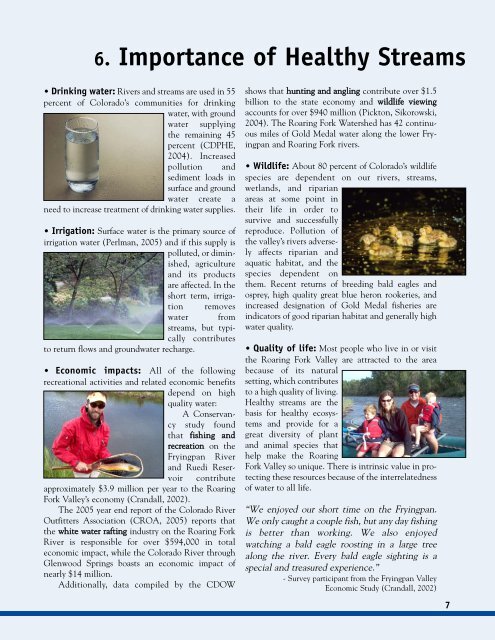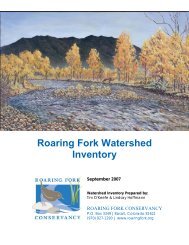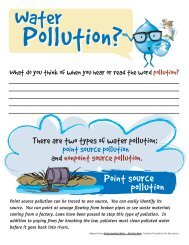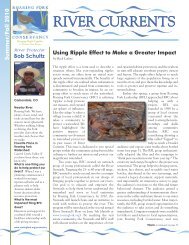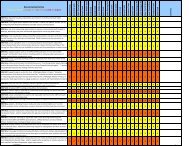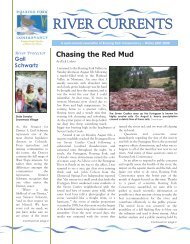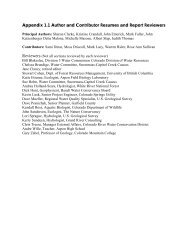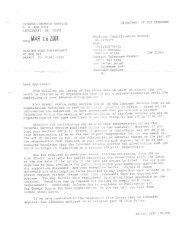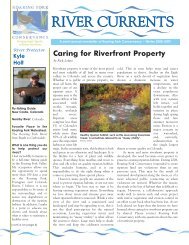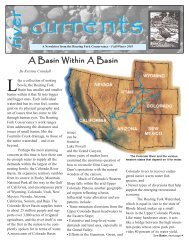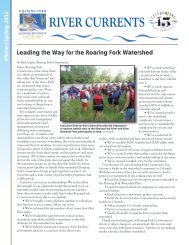2006 Roaring Fork Watershed Water Quality Report
2006 Roaring Fork Watershed Water Quality Report
2006 Roaring Fork Watershed Water Quality Report
- No tags were found...
Create successful ePaper yourself
Turn your PDF publications into a flip-book with our unique Google optimized e-Paper software.
6. Importance of Healthy Streams• Drinking water: Rivers and streams are used in 55percent of Colorado’s communities for drinkingwater, with groundwater supplyingthe remaining 45percent (CDPHE,2004). Increasedpollution andsediment loads insurface and groundwater create aneed to increase treatment of drinking water supplies.• Irrigation: Surface water is the primary source ofirrigation water (Perlman, 2005) and if this supply ispolluted, or diminished,agricultureand its productsare affected. In theshort term, irrigationremoveswater fromstreams, but typicallycontributesto return flows and groundwater recharge.• Economic impacts: All of the followingrecreational activities and related economic benefitsdepend on highquality water:A Conservancystudy foundthat fishing andrecreation on theFryingpan Riverand Ruedi Reservoircontributeapproximately $3.9 million per year to the <strong>Roaring</strong><strong>Fork</strong> Valley’s economy (Crandall, 2002).The 2005 year end report of the Colorado RiverOutfitters Association (CROA, 2005) reports thatthe white water rafting industry on the <strong>Roaring</strong> <strong>Fork</strong>River is responsible for over $594,000 in totaleconomic impact, while the Colorado River throughGlenwood Springs boasts an economic impact ofnearly $14 million.Additionally, data compiled by the CDOWshows that hunting and angling contribute over $1.5billion to the state economy and wildlife viewingaccounts for over $940 million (Pickton, Sikorowski,2004). The <strong>Roaring</strong> <strong>Fork</strong> <strong><strong>Water</strong>shed</strong> has 42 continuousmiles of Gold Medal water along the lower Fryingpanand <strong>Roaring</strong> <strong>Fork</strong> rivers.• Wildlife: About 80 percent of Colorado’s wildlifespecies are dependent on our rivers, streams,wetlands, and riparianareas at some point intheir life in order tosurvive and successfullyreproduce. Pollution ofthe valley’s rivers adverselyaffects riparian andaquatic habitat, and thespecies dependent onthem. Recent returns of breeding bald eagles andosprey, high quality great blue heron rookeries, andincreased designation of Gold Medal fisheries areindicators of good riparian habitat and generally highwater quality.• <strong>Quality</strong> of life: Most people who live in or visitthe <strong>Roaring</strong> <strong>Fork</strong> Valley are attracted to the areabecause of its naturalsetting, which contributesto a high quality of living.Healthy streams are thebasis for healthy ecosystemsand provide for agreat diversity of plantand animal species thathelp make the <strong>Roaring</strong><strong>Fork</strong> Valley so unique. There is intrinsic value in protectingthese resources because of the interrelatednessof water to all life.“We enjoyed our short time on the Fryingpan.We only caught a couple fish, but any day fishingis better than working. We also enjoyedwatching a bald eagle roosting in a large treealong the river. Every bald eagle sighting is aspecial and treasured experience.”- Survey participant from the Fryingpan ValleyEconomic Study (Crandall, 2002)7


